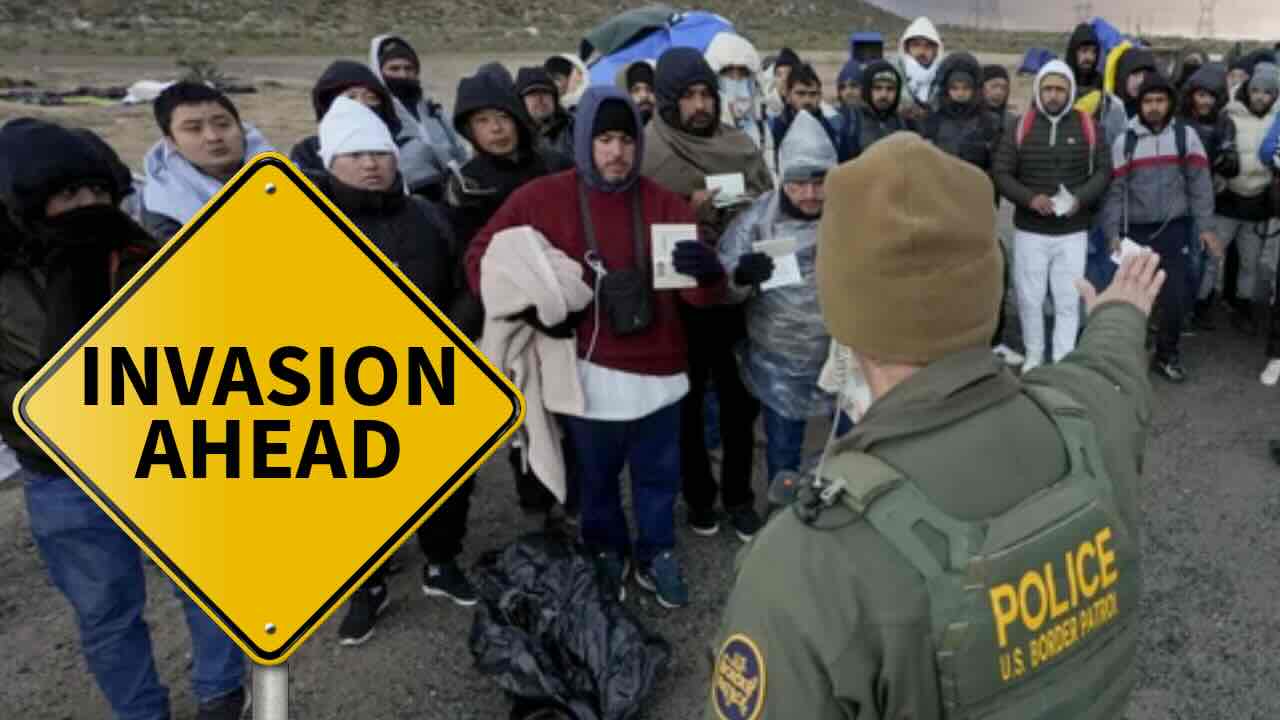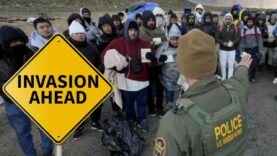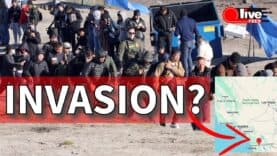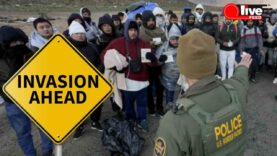We investigated the Southern border. And here is what we found
No matter what your political views are, by now you’ve probably heard about the border crisis. In our new coverage, we’ll try to answer your questions and also show you the crisis from the inside, and how the system is operating.
Even though the current border issues go far beyond just the border, and you’ve probably heard stories out of places like Chicago, New York, and New Jersey, the border is where it all starts.
In just about two years, since FY 2021, U.S. Customs and Border Protection (CBP) has logged over 9 million illegal border crossings, and 90% of them (about 7.5 million) happened at the Southwest land border. Additionally, since FY 2021, there are also almost 2 million known “gotaways.” A “getaway” is a border crosser who was detected by the CBP technology but never apprehended. These are only the official numbers provided by the CBP. However, some experts say the actual number of illegal border crossings might be even higher.
With most attention focused on Texas and Arizona, the border crisis in California mainly stays out of the picture. We decided that it’s time to change that, and investigated what’s actually happening on the ground — and what you will see in our video might actually shock you.
We started our journey with the US-Mexico border in San Diego, specifically at the San Ysidro Port of Entry — the largest land border crossing not only in the US or in America, but also in the Western hemisphere.
Border officials say they’ve seen a growing number of people on the FBI’s terrorist watchlist trying to enter the country through the U.S.-Mexico border.
According to FBI Director Christopher Wray, the terror threat facing the United States has now reached unprecedented levels. Of almost 10 million people who crossed the border illegally, how many terror suspects are now in the country? Well, we don’t really know.
When we arrived in San Ysidro in the morning, we saw about a dozen people standing in front of the Port of Entry building. All of them were of different nationality, age and gender. However, they all had one thing in common: they were holding a white paper with the Notice to Appear written on top of it. Notice to Appear is an official document that’s issued to illegal migrants who claim asylum at the border and provides a date they have to show up in court for their removal proceedings. On their initial hearing, the immigration judge will decide whether their asylum case has merit. And if it does, they will have other hearings afterwards. Depending on the state, port of entry, and time of year, the initial court dates on the Notices to Appear can be as far away as 10 years — and during this timeframe, illegal migrants stay in the US.
The local border patrol had a No Trespassing sign posted in front of the Port of Entry building and the officer did not let us anywhere near the entrance. As a legal port of entry, it’s clear that San Ysidro is just the tip of the iceberg. If we want to find out what’s actually happening at the border, we have to go to the places that facilitate illegal entry, which in simpler words means just the holes in the border wall.
You cannot fully grasp the current situation until you talk to the locals and see the rural border towns with your own eyes. For that purpose, we took a longer route, going through the twists and turns of the San Diego mountains. Apart from a few border patrol vehicles and breathtaking scenery along the way, there wasn’t much to talk about until we got to the small rural border towns of Campo and Jacumba.
One of the local residents shared that he saw “busloads of illegal migrants” every single day while driving home from work.
We had a chance to speak with several other local residents, and all of them also pointed us to the migrant camp right outside of town. There was no one there when we arrived but we didn’t give up and kept driving. In about 10-15 minutes, we found another county access road going to the border, and it led us to another migrant camp.
It was a sunny afternoon, and after discovering the abandoned migrant camp, we decided to return to Jacumba to get some water and talk to the locals more. Here, everyone is aware of the border crisis, and everyone has seen the busloads of illegal migrants daily. People are upset about the situation at the border but are usually afraid to talk on camera, and some of them even shared they’re afraid of the Mexican cartels.
When talking about the illegal migrant camps, locals mentioned that a lot of the illegal migrants they’ve encountered are Chinese.
One of the local residents pointed us to another migrant camp, near Lake Domingo. There was no address or clear directions (as you can imagine — Google doesn’t know that spot), so we had to go through some trial and error to get there. The local residents we met referred to that migrant camp as a Chinese encampment, specifically. They were also able to show us how to get to the camp, as it was hidden from the main road. After about a 15-minute drive through the bumpy and dusty rural roads of San Diego County, we discovered the migrant camp, and most of the migrants there were indeed military-age Chinese men. Check out our video!
As we were leaving for the day, we saw with our own eyes what the locals meant when they said the migrants were “coming by busloads daily.”
Of course, it’s important to mention that the current situation at the border is not only a security issue but also a humanitarian one. It’s hard to blame people running away from physical danger or simply looking for a better life — after all, this is human nature. The United States of America is a country of immigrants. However, immigration and entry laws have been put in place for a reason, and everyone we spoke to during this filming pointed out that the current levels of illegal migration are simply not sustainable for the system and the country as a whole.
Just as a quick comparison, 9 million illegal migrants who entered the US just for the past few years since FY 2021 is bigger than the current population of most US states, 38 states to be exact. A few other journalists who cover the border crisis discovered multiple IDs thrown away at the border. If all of us need a government-issued ID to go to another country, how do those who throw away their IDs get in? Is it enough for them just to say who they are, and they are admitted? And most importantly — why do they throw away their IDs in the first place? In a lot of cases, it means they simply do not want their real name to get a “hit” through a criminal or terrorist watchlist database.
A lot of times, out of lack of knowledge, people mix up legal and illegal immigration into one term. However, these two terms are significantly different. Legal immigrants are thoroughly checked and vetted. Illegal immigrants are not. And with the record high illegal border crossing numbers, it gets easier and easier to slip through the cracks of the broken system. Additionally, in many states, illegal migrants are now provided with free housing, food, and insurance — at the taxpayers’ cost.
Those who have a prior criminal record cannot obtain a visa to the US. However, under the current border procedures, some of them are able to illegally cross the border and remain in the country indefinitely. As a result, we do not know who gets into the US in the record-breaking numbers — the numbers we’ve simply never seen before. Based on what we saw in Jacumba, most of the illegal migrants were Chinese military-age men. Locals referred to these camps as “Chinese encampments,” specifically. According to the local deputy sheriff and also the official CBP numbers, thousands illegally cross the border daily only at that location.
According to the official CBP data, the number of Chinese nationals apprehended at the border in 2023 increased by more than twice since 2021. Additionally, Chinese encounters within the months of October-December of 2023 almost surpassed the numbers for the full years of 2021 and 2022.
Of course, we should not forget that China is a communist country, and many of these people run from physical danger and repression. But without the proper entry and immigration procedures in place, it’s really hard to distinguish those who need help from those who have bad intentions. And of course, that equally applies to any nationality.
Because of such unprecedented numbers of illegal border crossings, many call this an invasion. After everything you’ve seen in this video, do you think this term is an overstatement? Let us know what you think in the comments on YouTube — we’d love to hear your opinion! If you find what you’ve seen in our coverage as concerning, share this video with your local elected representatives and the media. Share this information with as many people as you can. Ask questions, and be informed of what’s happening around you.
This is only the first part of our border crisis series, and in the next episode, we’ll show you how the holes in the border wall look like, and how the operation is set up from the Mexican side of the border. If you have any questions on the border crisis, please drop them in the comment section on YouTube — we will go over all of them. Also, if you have any insight into what’s happening at the border and what you feel needs to be covered — please email us so we can investigate.
Do you have anything else to share or add to this coverage? Sign up for a free account, and post directly to our LiveFEED! Subscribe to our YouTube channel here. If you’d like to support independent investigative journalism, join our channel as a Member!
The next video is coming up shortly. Subscribe to our channel to stay tuned!





























